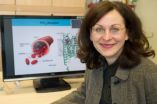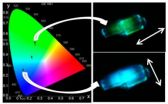(Press-News.org) WEST LAFAYETTE, Ind. - Significant tornado outbreaks and especially strong tornadoes are more likely occur within periods of activity lasting three or more days, according to a Purdue University tornado expert.
Jeff Trapp, a professor of earth, atmospheric and planetary sciences, examined 30 years of U.S. weather records and found that an outbreak of 20 or more reported tornadoes had a 74 percent probability of occurring during a period of tornado activity lasting three or more days. During those same periods, a tornado rated 3 or higher on the Enhanced Fujita scale had a 60 percent probability of hitting.
The Enhanced Fujita scale rates tornadoes from EF0 to EF5 with damage rated as "light," including broken branches and windblown signs, to "incredible," including leveling of strong-frame houses.
"Two extreme tornado events last year led to 32 deaths, injured more than 377 and cost $2 billion in damage and inspired this study," Trapp said. "Unfortunately, the devastating tornadoes these past few days, tragically, seem to be bearing out the results."
Tornadoes swept through Arkansas, Oklahoma, Kansas, Missouri, Nebraska, Iowa and Mississippi on Sunday (April 27); Mississippi, Alabama and Tennessee on Monday (April 28); and North Carolina on Tuesday (April 29). The National Weather Service received 100 preliminary tornado reports for April 27 and 28, and multiple deaths have been attributed to the violent storm system.
Trapp also found the multiple-day periods were more likely to occur during the warm months of April through July.
"The encouraging news is that the larger, more slowly evolving and moving systems that appear to contribute to multiple-day tornado periods may be more predictable," he said. "The weather system responsible for the tornadoes this week falls in this category and was revealed in the forecast models at least five days in advance with good fidelity."
Trapp examined tornado activity entered into the National Oceanic and Atmospheric Administration's historical record of tornadoes in the United States from 1983-2012, which included 3,129 tornado days and 1,406 unique periods of tornado activity. Multiple-day periods made up 24 percent of the unique periods of activity.
A paper detailing his study and the results was published in the April issue of the journal Monthly Weather Review and is available online.
The idea for the research began while Trapp was participating as a lead investigator in the National Science Foundation's Mesoscale Predictability Experiment (MPEX), a national field project to improve predictions of severe weather.
INFORMATION:
Writer: Elizabeth K. Gardner, 765-494-2081, ekgardner@purdue.edu
Source: Jeff Trapp, 765-496-6661, jtrapp@purdue.edu
Related websites:
Purdue Severe Weather Research Group: http://web.ics.purdue.edu/~jtrapp/severe/
Related releases:
Purdue part of field study to improve severe weather forecasting: https://www.purdue.edu/newsroom/releases/2013/Q2/purdue-part-of-field-study-to-improve-severe-weather-forecasting.html
Purdue swept up in largest tornado field study in history: https://news.uns.purdue.edu/x/2009a/090521TrappVORTEX2.html
ABSTRACT
On the Significance of Multiple Consecutive Days of Tornado Activity
Robert J. Trapp
Motivated by the temporal behavior of recent high-end tornado events, a 30-year historical record of tornadoes in the United States is examined for multiple-day periods of tornado activity. Comprising the 3,129 tornado days during 1983-2012 are 1,406 unique, nonoverlapping periods. Only 24% of these periods have lengths of 3 or more days. However, the conditional probability of such a multiday period given an outbreak day (OB; one with 20 or more tornado reports) is 74%, and give a significant tornado day [SIGTOR; one rated Fujita /enhanced Fujita (F/EF) ≥ 3] is 60%. Alternative ways of expressing these conditional probabilities all lead to the conclusion that SIGTORs and/or OBs are more likely to be contained within multiday periods of tornadoes than within 1-2 day periods. Two additional conclusions are offered: 1) SIGTORs and OBs have a relatively higher likelihood of occurrence during the latter half of the multiday periods, and 2) SIGTORs and OBs have a relatively higher likelihood of occurrence during the warm months of April-July. A hypothesized connection, illustrated using reanalysis data from 2013, is proposed between such behaviors and the characteristics of the larger-scale meteorological forcing. Some speculations are made about possible relationships between multiday periods of tornado activity and convective feedbacks, extended predictability, and modes of internal climate variability.
Multiple consecutive days of tornado activity spawn worst events
2014-04-30
ELSE PRESS RELEASES FROM THIS DATE:
MS researchers find brain & cognitive reserve protect long-term against cognitive decline
2014-04-30
West Orange, NJ. April 30, 2014. Multiple sclerosis researchers have found that brain reserve and cognitive reserve confer a long-term protective effect against cognitive decline: Sumowski JF, Rocca MA, Leavitt VM, Dackovic J, Mesaros S, Drulovic J, Deluca J, Filippi M. Brain reserve and cognitive reserve protect against cognitive decline over 4.5 years in MS. Neurology. 2014 Apr 18. doi: 10.1212/WNL.0000000000000433 [Epub ahead of print]. James Sumowski, PhD, lead author of the article, and John DeLuca, PhD, are at Kessler Foundation. Co-authors are from the Manhattan ...
'US Should significantly reduce rate of incarceration,' says new report
2014-04-30
WASHINGTON -- Given the minimal impact of long prison sentences on crime prevention and the negative social consequences and burdensome financial costs of U.S. incarceration rates, which have more than quadrupled in the last four decades, the nation should revise current criminal justice policies to significantly reduce imprisonment rates, says a new report from the National Research Council.
A comprehensive review of data led the committee that wrote the report to conclude that the costs of the current rate of incarceration outweigh the benefits. The committee recommended ...
Seeing the bedrock through the trees
2014-04-30
University of California, Berkeley, geologist William Dietrich pioneered the application of airborne LIDAR – light detection and ranging – to map mountainous terrain, stripping away the vegetation to see the underlying ground surface.
But that didn't take him deep enough. He still couldn't see what was under the surface: the depth of the soil, the underlying weathered rock and the deep bedrock.
He and geology graduate student Daniella Rempe have now proposed a method to determine these underground details without drilling, potentially providing a more precise way to ...
Hope for better drugs to treat stroke and heart attacks
2014-04-30
An international team of researchers in cooperation with the University of Bonn has taken two "snapshots" of a receptor which are of critical importance for blood coagulation. The scientists now hope to be able to develop novel drugs using these results. These include tailor-made blood-thinning substances for heart attack and stroke patients whose effects are reversible and better controllable than those of current therapies. The researchers are presenting their results in the renowned journal "Nature."
After a cut to the finger, blood platelets come into play: they adhere ...
Should the EU ban on the import of seal products stand?
2014-04-30
Next month, following an appeal by Canada and Norway to overturn the EU ban on the import of seal products, the World Trade Organization (WTO) is expected to announce whether the 2013 decision will be upheld. In an editorial article, a University of Bristol academic, whose research on the animal welfare of the seal hunt has been used in the case, explains why the ban should stand.
The article by Dr Andy Butterworth, Senior Lecturer in Animal Sciences at the University of Bristol's School of Veterinary Sciences and an official observer of the seal hunt is published in ...
Prostate cancer and blood lipids share genetic links
2014-04-30
Numerous studies have suggested a relationship between cardiovascular disease risk factors and prostate cancer. A new study by researchers at the University of California, San Diego School of Medicine, with colleagues in Norway, significantly refines the association, highlighting genetic risk factors associated with low density lipoprotein (LDL) cholesterol and triglycerides as key players and identifying 17 related gene loci that make risk contributions to levels of these blood lipids and to prostate cancer
The findings, published in the April 30, 2014 online issue of ...
New hybrid material that changes colour according to the direction of the light
2014-04-30
This news release is available in Spanish. The aim with respect to hybrid materials with one organic component and another inorganic one is to combine the best attributes of each one into a single system. Labs across the world are working to develop new hybrid materials for technological applications in nanotechnologies, in particular, and these materials are already being used in lightweight materials for cars, sports equipment, in biomimetic materials, like prostheses, etc.
The hybrid material being sought after by the research group in the Department of Physical ...
Neanderthals were not inferior to modern humans, says CU-Boulder study
2014-04-30
The embargo has been lifted for the article, 'Neandertal Demise: An Archaeological Analysis of the Modern Human Superiority Complex.'
If you think Neanderthals were stupid and primitive, it's time to think again.
The widely held notion that Neanderthals were dimwitted and that their inferior intelligence allowed them to be driven to extinction by the much brighter ancestors of modern humans is not supported by scientific evidence, according to a researcher at the University of Colorado Boulder.
Neanderthals thrived in a large swath of Europe and Asia between about ...
Columbia engineers grow functional human cartilage in lab
2014-04-30
New York, NY—April 30, 2014—Researchers at Columbia Engineering announced today that they have successfully grown fully functional human cartilage in vitro from human stem cells derived from bone marrow tissue. Their study, which demonstrates new ways to better mimic the enormous complexity of tissue development, regeneration, and disease, is published in the April 28 Early Online edition of Proceedings of the National Academy of Sciences (PNAS).
"We've been able—for the first time—to generate fully functional human cartilage from mesenchymal stem cells by mimicking in ...
Throwing injuries no longer just for the pros
2014-04-30
ROSEMONT, Ill.—Baseball season is back and so are the injuries. But, elbow injuries, once seen as a problem for professional athletes, are becoming more prevalent among high school and middle school athletes due to increased play and competition at the youth level. Repetitive stress to a pitcher's ulnar collateral ligament (UCL)—an important stabilizing ligament of the elbow joint—can lead to pain and eventually to the inability to pitch and throw.
According to a literature review in the May 2014 issue of the Journal of the American Academy of Orthopaedic Surgeons (JAAOS), ...



